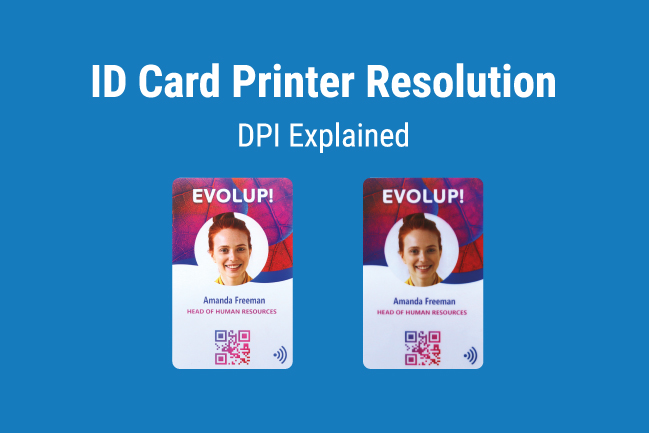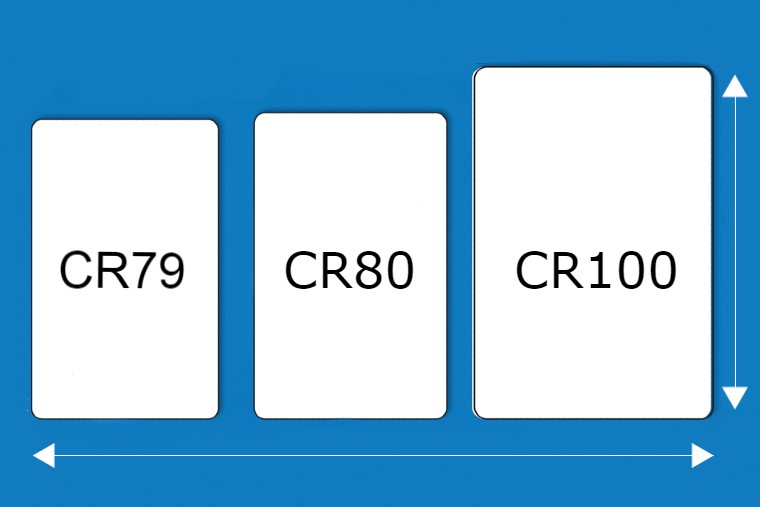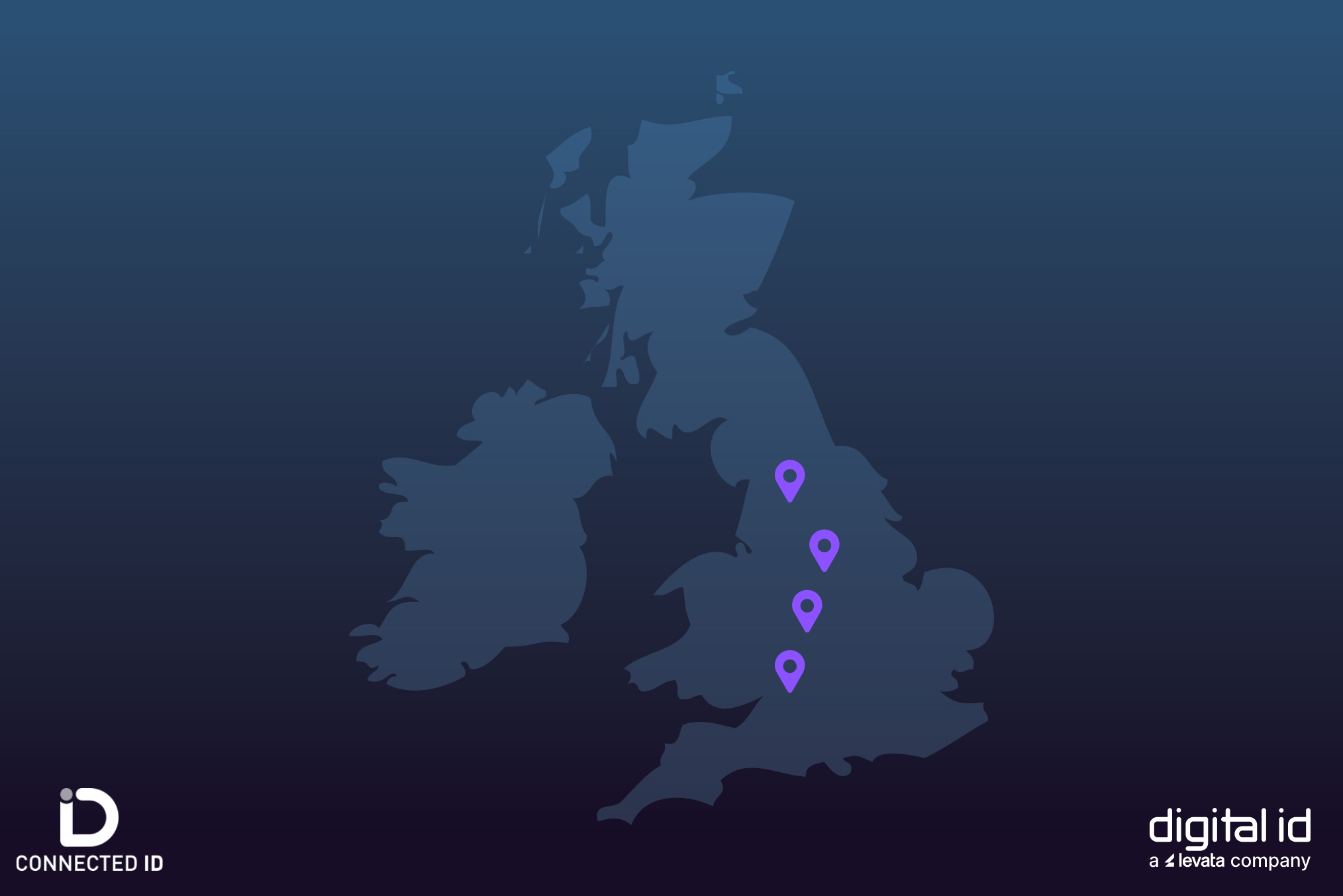An ID card printer is a key investment for any organisation and a crucial piece of equipment post-COVID-19. With a range of models and features on offer, finding the plastic card printer to fit your needs can seem a little daunting, so we’ve created a simple ID card printer buying guide to ensure you make the right choice.
Step 1: How much does an ID printer cost?
A lot of first-time buyers ask how much do card printers cost? The honest answer is that it can greatly vary depending on what you are looking for in an ID card printer.
Single-sided printers are more affordable and great for smaller businesses new to card printing. However, if you need to display more information or increase visual security, you will benefit more by upgrading to dual-sided printing or an ID card printer with more security modules included.
The print speed, security features, print quality, and print volume you require will all affect the final price tag. The points below however aim to provide an in-depth breakdown of these features and help you decide on the right printer for you.
Find out how to determine your card printer budget and which machine can best help you.
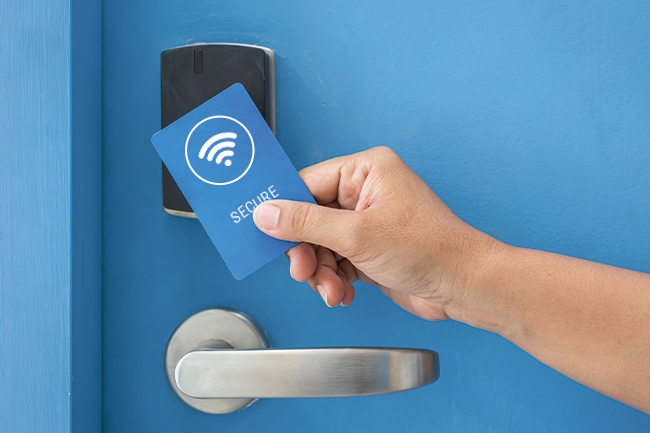
Step 2: What type of card will you be printing on?
Before you purchase an ID card printer, it’s good to figure out what type of cards you’ll be printing onto. Will you be printing photo ID, loyalty cards and membership cards, or does your business use access control (door entry) and proximity cards such as MIFARE and HID cards?
This is an important point because many access control smart cards contain a tiny computer chip that gives the card surface a slightly raised edge. This means using a machine such as a direct-to-card printer can affect print quality and damage the printer, so you must use a retransfer printer or an inkjet printer if you are printing onto access control cards.
Blank photo ID card printers are best for you if:
- You do not require access control credentials or door entry
- You want a simple design including a name, photo, job title, department
- You require just one logo or visible image
- You don’t mind a small visible white border
An access control card printer is best for you if:
- You need to create smart cards programmed for an access control system
- You want a more complex card design
- You want information printed on both sides of your ID card
- You want multiple images, colours or logos
- You don’t want any white borders around the edge of a card
Step 3: What type of ID card printer is used for ID cards?
After settling on which type of card you require, the next step is to decide which printer will meet your needs best. Before you proceed, we’d suggest watching this helpful video to give you a better understanding of the print methods available:
To choose the right printer for you, it’s important to consider the following:
- Whether you are printing on to access control smart cards
- The image quality you require
- The print volume you require
- The level of printer and card security you require
There are several distinct types of ID card printers available including:
- Direct-to-card printers
- Retransfer printers
- Inkjet printers
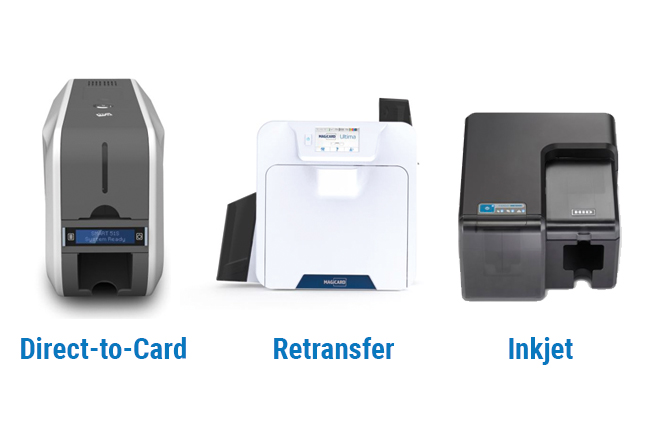
Which ID card printer is best for you?
Direct-to-card printers
Direct-to-card printers remain the most popular type of ID card printer due to a combination of attractive pricing and ease of use and are typically the solution for beginners or those with low volume printing requirements. Card printing with a direct-to-card machine will leave a small white border on printed ID cards as the printhead is not designed for printing over-the-edge of cards.
A direct-to-card printer does what it says on the tin, it prints directly onto the card surface using a process called “dye-sublimation” to offer faster print speed and lower cost per card than competitor ID card printers.
Consider a Direct-to-Card (DTC) printer if you:
- Need simple card designs with basic photos, logos and text
- Want to keep the cost of consumables such as printer ribbons to a minimum
- Don’t need to print to a form of access control card
Retransfer printers
Retransfer printers are much more effective printing machines than direct-to-card printers thanks to their two-step production process. Using a process called “reverse transfer” printing, your design is printed onto the reverse side of a clear film which is then heat adhered onto the full card surface. Retransfer printers are the most capable of printing over-the-edge designs onto ID cards with uneven surfaces due to the unique print method this technology uses.
In short, retransfer printing creates longer-lasting durable cards and allow you to print onto access control smart cards without the final image being compromised.
Consider a retransfer ID card printer if you:
- Need to print onto access control cards
- Want high-definition image quality
- Require over-the-edge card coverage
- Want a long-lasting ID card that doesn’t fade over time
Inkjet card printers
Inkjet ID card printing is a new technology. It makes printing onto plastic cards as easy as possible thanks to the use of a simple snap-in cartridge rather than a printer ribbon. Inkjet printing onto plastic cards offers a fair middle-ground between retransfer and direct-to-card printers, with strong print speed and over-the-edge printing in one user-friendly machine.
The Fargo INK1000 inkjet card printer is capable of printing high-definition text and imagery onto access control cards too.
Consider an inkjet ID card printer if you:
- Want your printer to be extremely user-friendly
- Need to print onto access control cards
- Require high-definition image quality
- Do not require holographic and highly secure watermarks
Find out more about the difference between retransfer & direct-to-card printers.
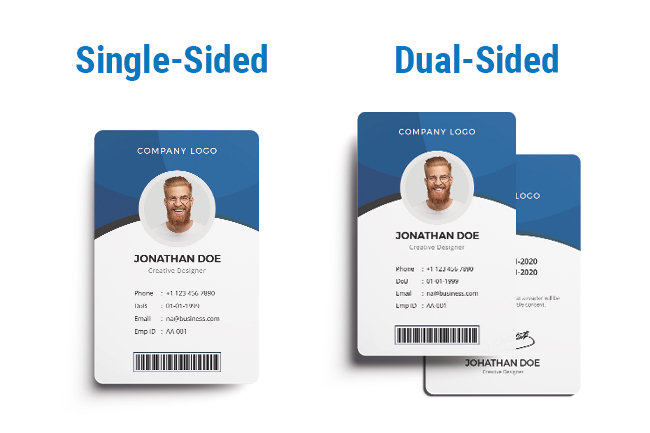
Step 4: Single-sided or dual-sided printer?
The next step is deciding if you need a single-sided or dual-sided printer. Single-sided printers are designed to print onto the face of ID cards and are great for businesses looking to introduce visual security measures such as photo ID cards into the workplace.
In 2021, we’re seeing more and more customers opt for the flexibility of dual-sided printing. Dual-sided printing effectively doubles the amount of card space you can print onto than if you were using a single-sided printer. You can upgrade to a dual-sided module add-on across the majority of our printers, and you can expect to pay between £100 and £300 extra depending on the make and the model.
A photograph, logo and personal data all play their part, but many people are now using ID to remind staff, students and visitors of safety procedures and policies in light of COVID-19. Dual-sided cards are a simple and extremely effective way of reminding people of new practices. Of course, you may simply want to make your information look less cluttered by opting for double-sided printing.
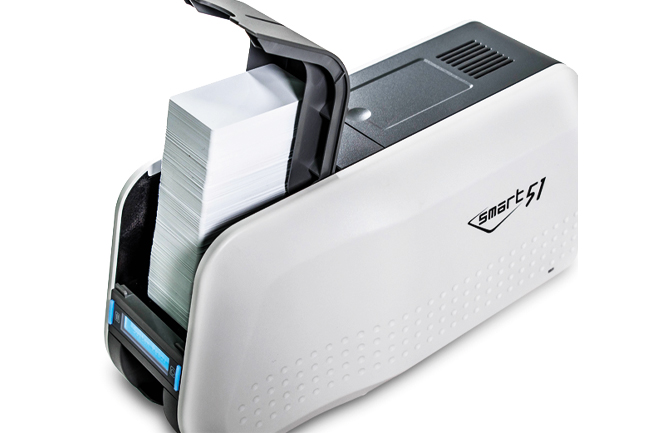
Step 5: What volume of cards do you require?
It’s really important to know the rough number of cards you need to print, be it on a daily, weekly or annual basis. Here are the main points you should consider when reviewing card print volume.
Print speed
All the ID card printers we sell are tested in-house for accurate print speed, which you can see in the full review section of the individual printer product pages. Full-colour cards can be printed in between 12 and 35 seconds each depending on the printer specifications. Obviously high volume printing will require a higher print speed in order to keep up with print demand.
Input and Output hoppers
Some printers designed for low-volume output are hand-fed, but many feature input and output hoppers. The hoppers feed the machine with blank cards and collect printed cards at the other end. The larger your hoppers, the longer you can go without having to load and unload cards.
Print yield
This will depend on the type of printer ribbon you are using. Aside from inkjet machines, all ID card printers use print ribbons. The larger the ribbon, the less you’ll have to change it and the cheaper it will cost in the long term. Most printer ribbons have a yield of between 250 and 500 cards.
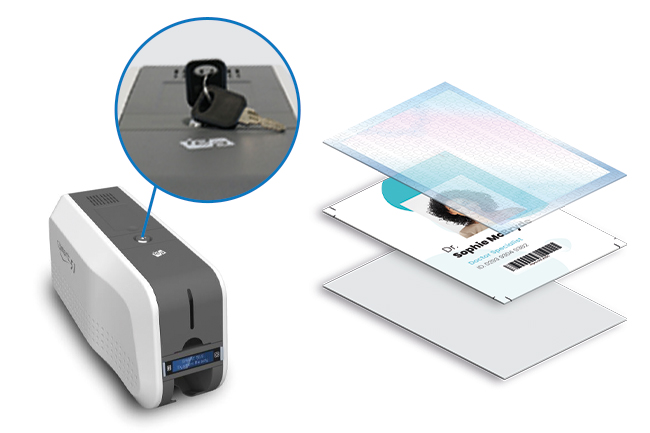
Step 6: What are your card security requirements?
At the end of the day, you’re buying an ID card printer to keep your site, staff and business as secure as possible. So what level of on-card security you require is a key consideration. There are several additional security features on offer depending on which manufacturer you choose, but these are the key ways to enhance the security of your ID card system.
UV Ink
Some printers are equipped to print cards using UV ink, which is only visible under a special light. This makes identifying cloned cards much easier. The UV ink is included as part of select printer ribbons, so it’s worth making sure the printer you choose can use UV ribbons if you need it.
Watermarks
Printing a visible, secure watermark onto your ID cards is a fantastic way of immediately enhancing your cards’ security. They are extremely difficult to clone, and many manufacturers offer their own unique watermark security systems for printed cards. These include Magicard’s Custom HoloKote and IDP Smart’s SmartMark.
Protecting your data
Printer security is just as important as card security these days. It’s incredibly important that personal data printed onto ID cards cannot fall into the wrong hands. For this reason, lots of manufacturers offer printers that eradicate the data as soon as it is printed. A great example is Magicard’s digital shredding feature and Fargo’s Resin Scramble. IDP Smart also offers a GDPR Secure model that features a lockable output hopper and Kensington Lock as standard.

Step 7: What about warranty and technical support?
The ID card printers we supply all come with manufacturer warranties of between two and five years. However, the vast majority feature three years of cover. Our dedicated in-house technical support team are also on hand to help you set up your printer: and all models come with 30 days free telephone support including set-up.
Step 8: What about software compatibility?
An often overlooked part of the card printer buying process is making sure your ID card printer is compatible with your computer operating system. The vast majority of our printers and supporting software here at Digital ID are Windows-based, so if you do require a machine that is compatible with macOS, make sure that it includes a Mac driver and works with your current operating system. Please note EasyBadge, our preferred choice of ID card design software, is not Mac compatible.
So what’s next?
Finding the right ID card printer will depend entirely on your own requirements, but we hope this buying guide has helped.
If you’re ready, shop our ID Badge Printer range starting at just £550, or grab everything you need in one box with our range of printer bundles starting at just £695.
Or you can speak to one of our friendly printer experts, who are happy to take your call, discuss your needs and help find out the machine for your individual needs. With no pressure to buy, they’ll assist you and help you find the best value for money machine along the way.
Call them today on 0800 988 2095 and quote “Printer Buying Guide”.

